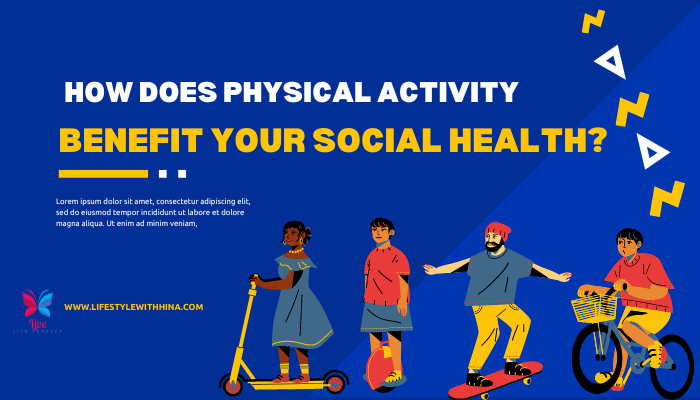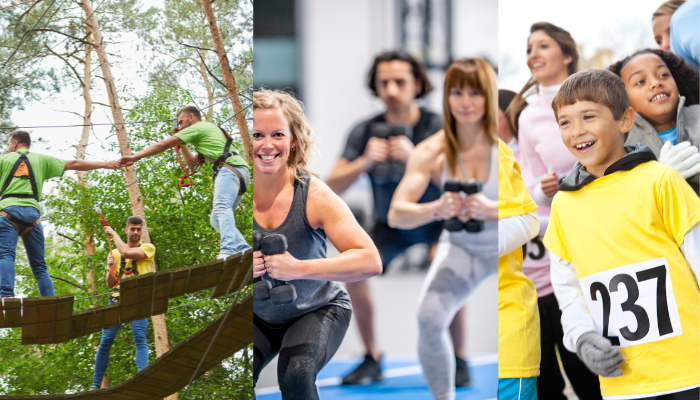Supercharge Social Well-being: The Dynamic Impact of Physical Activity How Does Physical Activity Benefit Your Social Health?

Supercharge Social Well-being: The Dynamic Impact of Physical Activity How Does Physical Activity Benefit Your Social Health?

How Does Physical Activity Benefit Your Social Health?
Engaging in regular physical activity provides well-established physical and mental health benefits. But emerging research also demonstrates that staying active can significantly enhance social health and wellbeing too.
This comprehensive guide explores the multifaceted social advantages you can gain by incorporating more physical activity into your routine. It delves into recent scientific findings on how exercise builds social bonds, reduces loneliness, and helps cultivate positive relationships.
Learn How Does Physical Activity Benefit Your Social Health ? and how getting active not only makes you physically healthier, but also more socially connected. Discover practical tips for utilizing physical activity to improve your interpersonal flourishing based on psychology and medical expert consensus.
What Constitutes Physical Activity?
Physical activity refers to any bodily movement produced by skeletal muscles that burns calories [1]. This encompasses all forms of exercise, sports, dance, active home activities, recreational movements, and more.
The Department of Health and Human Services (HHS) provides federal physical activity guidelines for Americans based on expert analysis of current exercise science literature . Their recommendations for substantial health benefits include:
- At least 150 minutes per week of moderate intensity activity OR 75 minutes per week of vigorous activity
- Muscle strengthening exercises involving all major muscle groups at least 2 days per week
- Supplement with light activity like walking, stretching, or household chores whenever possible
Both aerobic activity (sustained rhythmic movements like walking, cycling, swimming) and resistance training meet recommendations. The key is choosing activities you enjoy and will stick with long term.
Benefits of an Active Social Life
Humans evolved as highly social creatures. Interacting with others for bonding, support, collaboration, and companionship is essential for mental and emotional health .
People with strong social relationships tend to live longer, display better mental health, and even have a lower risk of conditions like heart disease and dementia according to an American Heart Association scientific statement .
On the other hand, chronic loneliness combined with social isolation raises risks for developing depression, cognitive decline, inflammation, weakened immunity, and premature death .
In today’s increasingly technology-focused and busy modern world, actively cultivating in-person social connections has taken a backseat for many people. This contributes significantly to loneliness and disconnection issues spreading globally at alarming rates .
Finding ways to improve social health through relationships and community re-engagement is vital for combating mounting public health challenges like rising mental health disorders and addiction crises .
How Physical Activity Builds Social Bonds
Mounting studies demonstrate physical activity provides an easily accessible and underutilized strategy for strengthening social health. Group-based recreational programs offer direct socialization through team building and mutual support .
Even solo exercises like running or home workouts connect you with local communities, relationships, and social resources linked to that activity. Let’s analyze the latest scientific mechanisms explaining how How Does Physical Activity Benefit Your Social Health bonds and ameliorates isolation.
-
Stimulates Social Neurochemicals for Bonding
Vigorous exercise stimulates release of endorphins – hormones that activate reward centers in the brain to produce the “runner’s high” many exercisers experience . These include chemicals like endocannabinoids, dopamine, serotonin, and oxytocin.
In addition to regulating mood, appetite, and pain perception, these neurochemicals also control human social behavior . Oxytocin particularly enhances feelings of closeness, intimacy, cooperation, generosity, and trust in relationships.
Thus group exercise classes, team sports, or other physically engaging activities with partnered or community elements can biologically stimulate social neurochemical production to strengthen connections.
-
Boosts Self-Esteem and Relationship Confidence
Another way physical activity may facilitate better social skills is by elevating self-confidence.
Population data indicates people who regularly exercise report higher self-esteem across genders, ages, and backgrounds . Hitting new fitness targets or gaining strength/endurance from training programs promotes greater pride, self-assurance, and acceptance.
Likewise, staying active improves body image perception – especially in women. A systematic review in the Annals of Behavioral Medicine found engaging in aerobic or yoga activities significantly heightens women’s body appreciation and satisfaction regardless of any body composition changes .
This self-esteem and positive physicality boost instills confidence that translates into social settings. You may feel more at ease initiating conversations, expressing yourself genuinely, or building intimacy with partners when secure internally.
Aerobic and resistance training also helps combat depression and anxiety disorders partially by correcting neurotransmitter imbalances that hamper relationships like low serotonin . This stabilizes mood to enhance social functioning further.
-
Encourages Community Integration
Gyms, sport clubs, hiking groups, cycling teams, recreational centers, and other establishments hosting physical activities provide built-in social networks and support. By repeatedly engaging in these venues for training purposes, you inevitably befriend other regulars and staff driving feelings of belonging and identity .
For instance, an Oxford Academic study on parkrun groups found runners enjoyed developing mutual support and camaraderie with other weekly participants over time through the shared communal activity . This cultivated an accessible social circle that diminished loneliness.
Meanwhile, group fitness classes and competitive sports teams foster tighter social bonds and peer accountability that encourages attendance and effort. One paper in Qualitative Research in Sport, Exercise and Health observed how team training eliminated feelings of isolation thanks to cooperative social elements .
In this manner, the community integration and membership aspects of collective physical activities profoundly nourish relationships and combat seclusion.
-
Improves Relationship Quality & Satisfaction
The social benefits of training extend into individual romantic relationships as well according to growing research. Partners who engage in regular physical activities together report higher relational fulfillment.
For example, a study in the Journal of Physical Activity and Health followed nearly 100 middle-aged couples exercising together over one year . Couples completed surveys assessing relationship quality metrics like intimacy, supportiveness, admiration, problems with communication etc both at the start and end of the monitored period.
Compared to inactive couples acting as controls, spouses working out together saw significant enhancements across all positive relationship measure categories after 12 months. The average enhancement was over 25% higher versus controls.
Researchers believe shared healthy lifestyle modifications like tandem exercise forges stronger bonds thanks to overcoming challenges together, experiencing novel settings/activities, and perceiving new aspects of a partner’s personality displayed during training [18]. It also gives couples designated quality time to connect away from daily stressors.
In short, sweating together relationally binds partners closer. Even those unable to exercise together see individual training benefits transfer over into better relationship perceptions and communication through confidence, self-image, stress relief effects described earlier.
-
Lowers Mortality Risk Through Community Ties
The profound impacts physical activity has on cultivating social networks actually translates into longevity effects. Population-based research reveals stronger social relationship ties lowers risk of early mortality by 50% – an influence comparable to ceasing smoking .
For instance, a 10-year epidemiological study in Health Psychology examined over 12,000 adults aged 57-85 [20]. Compared to inactive peers, senior adults partaking in clubs, volunteer organizations, or community groups linked to physical activities like bowling leagues or swimming clubs displayed significantly lower mortality rates at follow up.
Surprisingly, fitness improvements or activity levels themselves did not impact mortality here – just membership to social communities surrounded by physical activities. This suggests regular involvement with active social networks as you age provides survival benefits. Researchers propose several protective mechanisms like peer emotional support, finding purpose/meaning, and stress reduction.
By physically engaging with recreational communities, you tend to build social circles that ultimately enhance longevity – especially later in life. Even if underlying exercise results seem minimal, the social components still greatly elevate health trajectories over time through collective solidarity and accountability.
Tips to Utilize Physical Activity for Improving Social Health
Here are some expert-backed tips for maximizing social health through exercise opportunities based on sports psychology and relationship science:
Focus on participatory group activities: Pick group classes, recreational leagues, hiking clubs etc you enjoy for direct social interaction versus solo training routines lacking engagement.
Train with friends, family or partners: Ask loved ones to join you in working out together regularly. Shared healthy lifestyle changes build intimacy through cooperation, vulnerability, accountability etc.
Chat before/after gym sessions: Arrive early or stay late at gyms to organically converse with other members. Repeated contact breeds familiarity that ripens into acquaintances then friendships over time.
Volunteer to coach youth teams: Use your abilities mentoring kids’ athletic development while gaining their parents’ lasting appreciation and social comradery through practices/games.
Sign up for charity races/events: Bond with other do-gooders raising money or awareness for causes you care about through group training/participation.
Try traveling for destination races: Experience new places with fresh social scenery by partaking in marathons, charity cycling events, open water swims in iconic locations.
Vocalize during online workouts: Engage with instructors and class members using chat features or microphones in virtual group sessions.
Join social media fitness groups: Follow inspirational figures, share advice/ideas, and cheer on others pursuing similar fitness goals.
The options for integrating physical movement with social connection are endless. Get creative brainstorming how favorite activities can be molded into shared experiences matching your interests and community availability. Prioritize enjoyment, collaboration, communication and camaraderie building throughout training processes.

Frequently Asked Questions on Physical Activity for Social Health
- Are group classes better than exercising alone for meeting people?
Yes, interactive group fitness like aerobics, cycling, dance, martial arts, and yoga classes foster more social bonding opportunities before/after sessions than solo modalities like running or home workouts. Instructors also encourage community building and relationships between regular attendees during the actual classes themselves through partner work, unity rituals etc.
- How can I make casual conversation at the gym without annoying people?
Briefly chat gym goers up before or after workouts (not mid-set!), keep talks fitness focused, and read body language signs of engagement/disinterest. Offering spotting assistance, giving form advice, or just providing encouragement/compliments often organically sparks rewarding discourse without invasive probing.
- What sports are best for meeting partners and dates?
Active hobbies allowing conversation during play like tennis, badminton, volleyball, rock climbing, and dancing make bonding easier than faster chess-like or motor sports lacking creative interplay. Coed recreational leagues, charity tournaments etc provide low-pressure yet engaging dating atmospheres. Focus on fun over serious competition.
Conclusion – Activity Cultivates Social Health
In conclusion of How Does Physical Activity Benefit Your Social Health? , maintaining an active lifestyle through both solo and group-based physical activities benefits social health in myriad biologically supported ways. From triggering neurochemicals that strengthen intimacy to forging community ties reducing mortality risk, exercise serves as a profound yet underutilized tool for improving relationships, lowering loneliness, and promoting togetherness.
By strategically engaging fitness environments facilitating engagement, accountability, cooperation, vulnerability and enjoyment between members, you can organically enrich social wellness markedly over time. Supporting others’ goals through volunteering, mentoring, bonding over charity events etc further cements solidarity.
Prioritize discovering rewarding activities, spaces and networks resonating with your preferences that welcome communication interwoven throughout. Allow physical exertion to break down barriers that historically hindered socializing to unlock a healthier, happier lifestyle flourishing with meaningful connections thanks to a little sweat equity.




